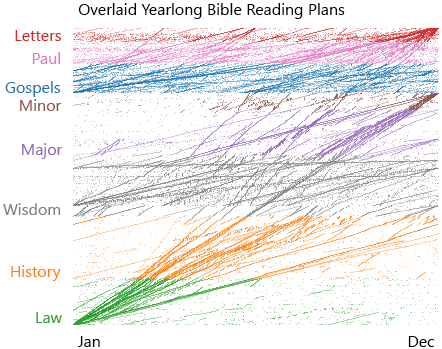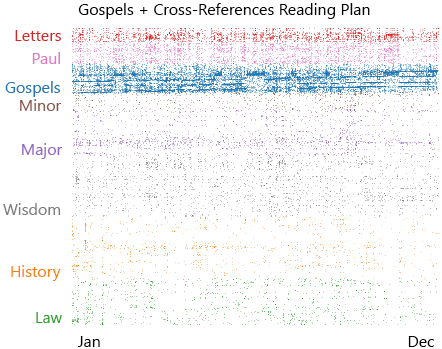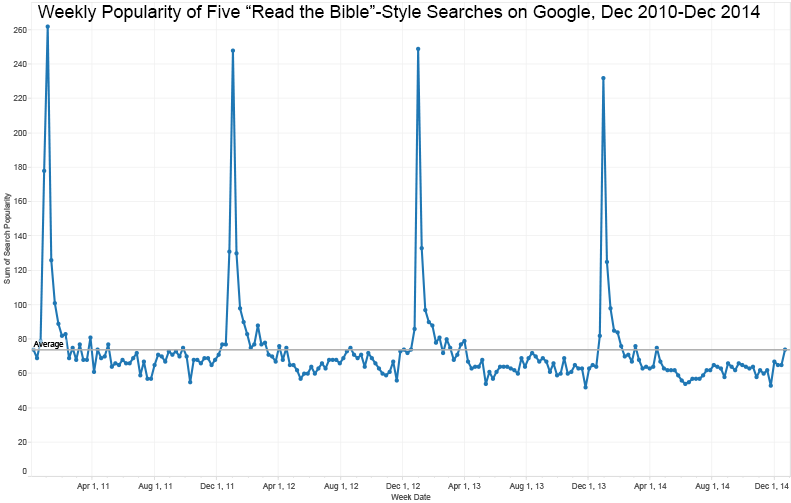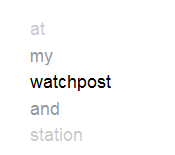Bible.com currently has 91 yearlong reading plans. By graphing these plans with time on the x-axis (January on the left, December on the right) and verse on the y-axis (Genesis at the bottom, Revelation at the top), we can divide them into four categories, labeled below:

First are continuous plans, which proceed in a sequential pattern through the Bible. They’re at the top of the above chart, characterized visually by strong lines proceeding from the lower left (January / Genesis) to the upper right (December / Revelation). They tend to cover substantial portions of the Bible, usually either the whole Bible or the complete New Testament. They generally ask you to read four or fewer distinct passages per day, with each passage about a chapter long.
Next are semi-continuous plans, which are the hardest kind to define. They feature stretches of reading that immediately follow from what you’ve just read, coupled with days of reading that are… not what you just read. You can see some lines go up to the left, similar to the continuous plans, and then they stop or dissolve into smaller sections. Defining a continuous vs. a semi-continuous plan is a matter of opinion; you could argue that some of the plans I’ve classified here as semi-continuous should be continuous. The most-interesting one to me is #34, the Book of Common Prayer Daily Office, whose pattern follows the liturgical year and doesn’t resemble any other plan on the chart. (Ten years ago I plotted both years of the Book of Common Prayer on a similar chart.)
Third are chronological plans, identifiable by their unique pattern of parallel passages in Kings and Chronicles (the parallel orange lines). Not all plans in this category are strictly chronological, but they have a similar organizing principle that produces the recognizable pattern of parallel paths.
Last are selections, which follow no discernible pattern and typically involve shorter readings–a few verses from multiple places in the Bible rather than reading full chapters. This kind of plan often includes devotional content related to the selected verses. The average plan in this category covers about 1,800 verses per year, or about 6% of the Bible’s 31,000 verses.
All the plans together
Here’s what all 91 plans look like overlaid on each other:

Paths radiate from Genesis in January through Job later in the year, varying mostly in the pace you’re reading the bulk of the Old Testament. In other words, if your reading plan starts by reading Genesis at the beginning of the year, you’re likely to proceed sequentially through the Old Testament until you reach Psalms. Similarly, paths converge on Malachi and Revelation in December.
Where are the digital-first plans?
The similarity among these plans suggests to me that they originate from a print-first mindset: what’s convenient to read in a physical Bible. You’re not, for example, going to flip to passages all over your print Bible every day unless you have unusually strong dedication to your reading plan.
But digital reading plans don’t have this limitation. Thanks to transclusion, a digital plan can collect content from all over the Bible (and elsewhere) and show it to you in one place, which means you can read much more widely on a single day if you like.
For example: let’s read through the Gospels chronologically in one year–that’s about ten verses a day–and also include ten cross-references for each verse every day. During a year, you read 14,104 different verses, or just under half the Bible. Here’s what the plan looks like schematically; you can see the paths through the Gospels, and overall it doesn’t look like any other plan:

And here’s what the content for a single verse from one day’s reading could look like (because there’s so much related text for each verse, this plan requires a little information design): the current Gospel verse is at the top. Below it are three columns: one for Old Testament references, one for other Gospel references, and one for non-Gospel New Testament references. I also included the same color-coding as in the other charts in this post.

Beyond transclusion, interactivity is a key property of digital systems. You could add interactivity by allowing the plan follower (with an interactive plan, they’re not just a “reader”) to configure the number of cross-references they read. Or tapping a cross-reference could open other verses they’ve read or will read as part of the plan–letting them explore more deeply and follow patterns as they desire. Adding interactivity to a system opens new avenues for insight.
Reading plans for augmented reality or audio-only interfaces will similarly vary in form from existing print-based plans. I would suggest that they will probably be even more conversational and dynamic than what I describe here.
I don’t know what shape future digital Bible reading plans will take, and the current approach of converting print-first plans to digital will certainly persist. But new digital-first reading plans will also come into being, and it’s important to experiment with what new technologies allow.






